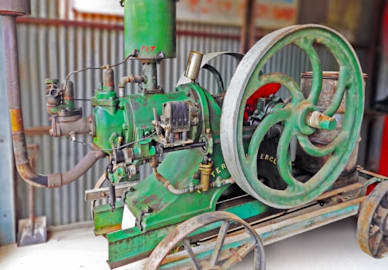This article was first written by David Hancock many years ago from his memories of the day that Southern Sky, one of the fleet of planes operated by Sir Charles Kingsford Smith through his company, Australian National Airways, was force landed by its pilots at Old Bonalbo in 1930. It is now 88 years since this event and David, now 95-years-old, remembers this event as clearly today as the day it happened.
On the inaugural mail service flight of Australian National Airlines the ‘Southern Sky’ was forced to make an emergency landing in most inhospitable, heavy timbered terrain at G.W. Minnis’ farm ‘Ulidia’, Duck Creek, Old Bonalbo on 1/1/1930.
Cyclonic weather conditions and poor visibility made this potentially dangerous action necessary - similar conditions caused the Stinson disaster to the north of ‘Ulidia’ seven years later on 19/2/37.
However with the late George Minnis’ knowledge and the pilots, C.E. Sheppard and Flight Lt. C. Ulm’s skill, fortune smiled at ‘Ulidia’, the ‘Southern Sky’ landed without injury to the occupants, perhaps more importantly without bursting into flames (still a hazard in these situations today), but sustained considerable damage to the undercarriage and one engine, caused by logs, rocks etc. An invaluable contribution by G. Minnis was responsible for the safe landing - he quickly assessed the situation, stripped the beds of sheets and placed them in the most advantageous positions, for the plane to have a chance of making a safe landing.

G. Minnis was probably the only person in that area with any knowledge of aircraft - he joined the Air Corps during the Great War for a short period, (rejected by colour blindness) therefore he had seen markers used in France; it was also in France that George Minnis met Charles Kingsford Smith, destined to meet again at ‘Ulidia’ many years later.
The passengers and their luggage were transported to Casino by road and they returned to Sydney by train (I wonder if they travelled by air again!) It was decided to repair the Southern Sky on the spot - Chief Engineer for ANA arrived, local mechanical genius the late John Crossett assisted. Repaired and stripped of all unnecessary fittings three weeks later it was ready to take to the air. The available runway length was little more than one third of the desired run. To overcome this problem the tail of the plane was tethered to a log by rope and a bag of sand placed on the tail (to lift the nose). With Kingsford Smith at the controls, after warming the motors and gaining full engine revolutions he signalled by dropping a white handkerchief. At that moment the late Jack McKee cut the rope with an axe; he was assisted by Dave Hamilton manipulating the rope.

The ‘Southern Sky’ took to the air magnificently, just clearing the timbered mountain, Smithy banked the plane neatly dislodging the bag of sand, waved to the crowd of onlookers and flew to Coffs Harbour, where refitment and further repairs took place, subsequently returning to Sydney.
The air mail service company, Australian National Airways, was founded by Sir Charles Kingsford Smith and Charles Ulm in 1929, though operations didn’t commence until January 1930. It was a short-lived venture, ceasing operations in 1931. Its aircraft fleet consisted of:
VH-UMF Southern Cloud (crashed March 1931)
VH-UMG Southern Star
VH-UMH Southern Sky
VH-UMI Southern Moon
VH-UNA Southern Sun (crashed November 1931).
Not many years later on 8th November 1935, Kingsford Smith and co-pilot, John Thompson (Tommy) Pethybridge disappeared over the Andaman Sea during their attempt in the Lady Southern Cross to break the England-Australia speed record. Though an immediate search was undertaken by Eric Stanley Greenwood OBE who was a test pilot, neither their bodies nor the plane was ever recovered - an undercarriage leg and wheel did wash up on Aye Island in the Gulf of Martaban off the coast of Burma approximately 18 months later and was confirmed by Lockheed to have been part of the Lady Southern Cross.
*David Hancock





